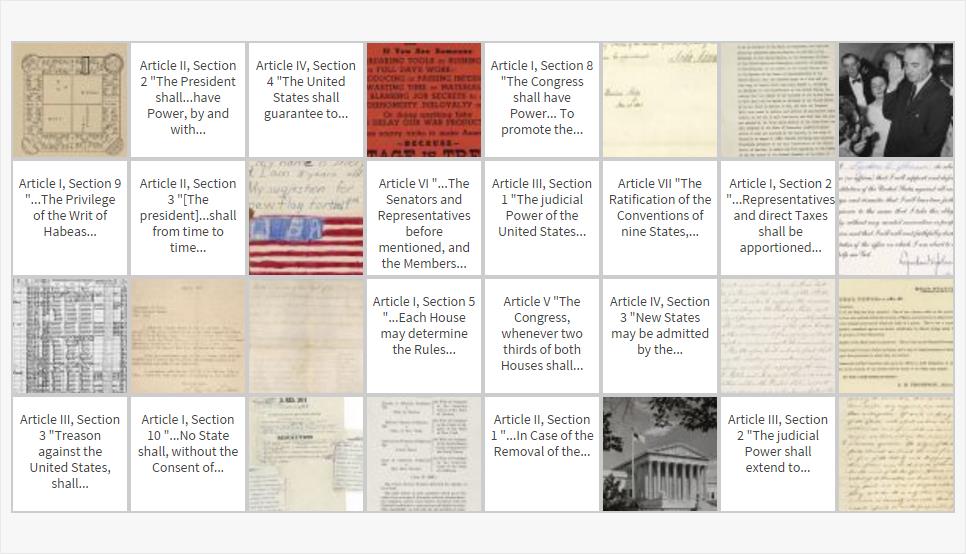 See activities created with the Seeing the Big Picture tool.Pair documents with descriptions, questions, or other documents. Ask students to make matches to reveal a larger historical image or document, representing the culmination of historical events or ideas from the activity.
See activities created with the Seeing the Big Picture tool.Pair documents with descriptions, questions, or other documents. Ask students to make matches to reveal a larger historical image or document, representing the culmination of historical events or ideas from the activity.Learning Objectives
- Recognize that historical outcomes are affected by the combination of numerous events, actions, and individuals
- Understand that events or ideas result from a number of smaller events, actions, and ideas
- Understand relationships between events, people, and ideas
- Understand that interpretations formed about the past must be supported by sufficient historical evidence
- Grasp that the understanding of history is tentative: differing sets of evidence lead historians to form differing conclusions
To Create a Seeing the Big Picture Activity:
- Go to My Activities and create a new activity.
- Choose documents to include; pull in all pages of a document, or only specific pages. Include both documents that students will use to create pairs, and the image that will be revealed when students finish matching. Add your own text for the matches if you'd like. You can also upload images to include documents, photographs, or other images from sources beyond the National Archives. Decide whether students will be able to access all of the details available for the documents (including dates and descriptions) or simply the document images and titles.
- Choose your grid size based on how many documents and other elements you have, and how many pairs you want students to create. Select the image that will be revealed when students finish matching. Use the full image or crop it to show a specific section.
- Match the documents and other elements in pairs, according to how you want your students to match them.
- Write instructions for your students, including an introduction and conclusion. You can include questions or a follow-up assignment in your conclusion. Students can email their responses to you if desired.
- Preview the student activity and create a snapshot.
- Lastly, describe your activity to other teachers by providing a summary. Tag it with the appropriate historical era, historical thinking skill, level of Bloom's Taxonomy, and grade level. You can also include detailed teaching instructions.
Teaching Tips
- Model document analysis with at least one document in the activity before asking students to begin interacting with the rest. Remind students to analyze all of the documents (and map, if using a historical one) carefully.
- Ask students to hypothesize what matches they'll make before beginning the activity. The exercise can act as a pre-assessment and can help to guide thinking. It establishes a purpose for viewing the documents and students will begin to contextualize them.
- Guide students on how they should make matches: text boxes describing concepts matching primary sources illustrating those concepts, primary sources matching other primary sources, or even text boxes matching text boxes.
- Follow activities with class discussion or writing assignments to further contextualize the documents and ultimate historical outcome.
- To help students understand how differing sets of evidence lead historians to form differing conclusions, ask students to do two different activities. Each should display the same payoff image when students finish matching the pairs, but you will choose different sets of documents for students to match. At the conclusion of both activities, ask students to contrast the views that historians might have after looking at just the documents in one activity versus the other.Consider the goals you have for your students before planning your activity. Choose documents and structure your activity based upon those goals.
- To open the activity up and allow students to show their creativity, lead a class discussion about matches made and ask students to explain other possible connections between documents. Use this as an opportunity to discuss how historians may view the same factors or sets of evidence in different ways.
- Or, ask students to suggest other documents, events, or ideas that could have been included. Encourage them to consider whether new evidence would change the historical narrative or their own conclusions.
- Help younger students practice basic document analysis and understanding cause-and-effect relationships. Construct an activity with simple written documents or photographs, posters, drawings, or audiovisual media. Walk students through careful document analysis, instructing them to look at the document first as a whole and then pay close attention to the details. Students decipher what each particular document is, then match that document to the appropriate title.



